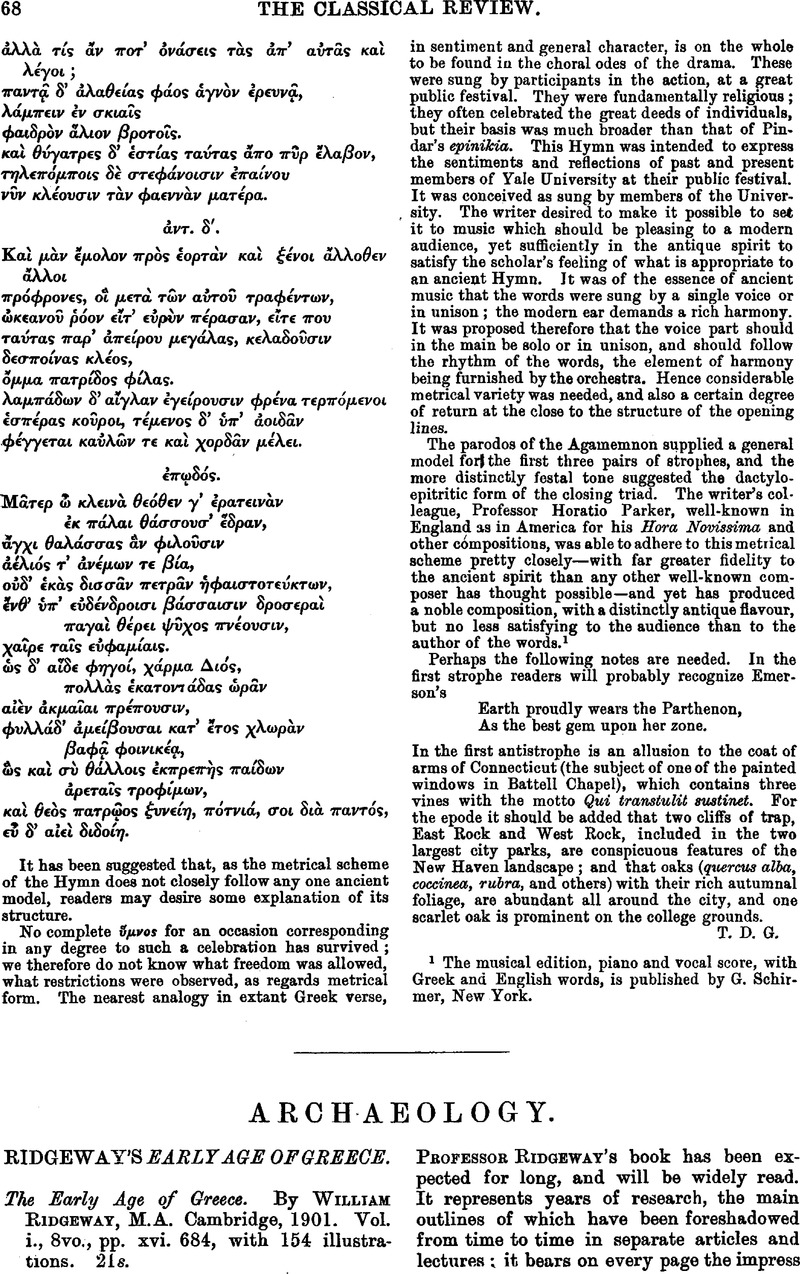No CrossRef data available.
Article contents
Archaeology
Published online by Cambridge University Press: 27 October 2009
Abstract

- Type
- Archaeology
- Information
- Copyright
- Copyright © The Classical Association 1902
References
page 69 note 1 E.g. Abusis for Abusir p. 55; Inwallich for Sowallich p. 611; Andulasia p. 374; ἁλόντι for ἁλέντι p. 615 n; Villano p. 606 and Vilanov p. 449, Villaneva; Lelegese p. 213; Gillan for Gillen 537; Lidenschmidt for Lindensehmidt p. 456; Loesche for Loeschcke p. 16 and throughont; Wedgewood for Wedgwood p. 77; Hample for Hampel, p. On pp. 5–6 a misplaced comma makes nonsense; p. 10 for ‘grasshoppers’ read ‘cicadas’; 9 fig. 3–5 for ‘buttons’ read ‘discs’ as in the text; p. 52 fig. 28 for 'bronze read ‘stone,’ (cf. Journ. Anthr. Inst. xxvii PI. xi. cf. p. 172, whence figure is taken without acknowledgment; p. 25 ‘Proto-Corinthian’ work is described as preceding ‘Mycenaean’; p. 22 the bronze warrior from Tiryns not ‘naked’; p. 47 if the swastika on the leaden figure from Troy is quoted at all, reference should be made also to Hoernes Urgesch. d. Kunst. p. 178, 344, or to v. d. Steinen Prähistorische Zeiehen p. 7, n. 3; p. 171 the Argo in Od. xii. 69–70 does not pass ‘Skylla and Charybdis,’ but the Planktai; p. 198 Cyprus is not ‘in the Aegean’; p. 206 the Cyprian Salamis is not the ‘modern Larnaka’; p. 16 the statement that ‘linear ornament, especially spirals, is found also in Cyprus, Phoenicia, Assyria, Thera, and Sicily’ is utterly misleading; on p. 207 comes a similar misleading phrase about rosettes in Cyprus; p. 435, the helmet from Glasinatz is described as ‘furnished with an αὐλὸς,’ but the figure on p. 434 shows that its crown is missing altogether, and no proof is given that it is not, as Truhelka says, a Greek helmet of a common classical type: p. 365 what ‘Aegean figurines’ are known from the Baltic coast? the figurines published by Mr. Evans are of local manufacture; p. 172 as to Pelasgians at Larissa, the reference to Il. ii. 237, and the inference from ναιετάαςκον are both wrong: the line is II. ii. 841: the tense is the same as in 11. 824, 828–835, 853: in 853 would Prof. Eidgeway argue, from the tense, that the Paphlagonians had been recently expelled from the head of the Adriatic?
page 70 note 1 E.g. p. 65, no reference to the discussion of the Khatana pottery, J.H.S. xvii 145 ff; p. 66, (‘now generally recognized as Libyan’), to de Morgan's Origines de l'Egypte, 1896, and subsequent controversies: p. 118, to Belger's criticism of Tsountas' tumulus-theory, Jahrb. 1895. 114; p. 147 it is surely needless, in 1901, to!discuss the Aegean theory of Montelius; p. 206, on the date-marks at Kurion, there is no reference to Petrie, Trans. Roy. Soc. Lit. 1897, 73 ff; most strange of all, the statements as to Hallstatt are all from von Sacken's book, published in 1868, three years before Schliemann's first campaign at Troy; there is not a single reference to the works of Hoernes, Undset, Worsaae, or Sophus Müller, in regard to the antiquities of Central Europe; and in matters of chronology the views expressed in Montelius' Civilisation Primitive en ltalie are adopted without qualification: e.g. p. 606 ‘archeologists are agreed’ that iron was introduced into Italy about 1000 B.C.
page 72 note 1 It is perhaps worth noting that on p. 195n Prof. Ridgeway appears to adduce Kretschmer in favour of the view that Karian and Lycian are akin to Greek. Kretschmer's conclusion in the passage cited (Einleitung, p. 376 sqq. Ridgeway. p. 195 n.) is exactly the reverse;—‘dass das Karische so wenig wie das Lykische ein indogermanisches Idiom seiu kann’ (p. 383, cf. p. 375).
page 77 note 1 Of this last point, again no proof. The socalled oracular inscriptions at Dodona are not responses, but questions.


